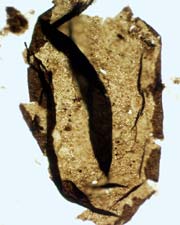Ancient Relatives of Algae Yield New Insights into Role of CO<sub>2</sub> in Earth’s Early Atmosphere

The microfossil that indicates high amounts of ancient CO2; in this image, it looks strangely like a human face. <br>Photo Credit: Shuhai Xiao at Virginia Polytechnic Institute <br>
Awareness of the global warming effects of carbon dioxide (CO2) is relatively recent, but the greenhouse gas has been playing a critical role in warming our planet for billions of years, according to University of Maryland geologist Jay Kaufman and Virginia Polytechnic Institute geologist Shuhai Xiao.
Their results, which provide the best evidence to date of the age of the Calvin cycle—the photosynthetic cycle by which plants convert light energy and CO2 into cellular tissue—will be published in the September 18 issue of the journal Nature.
The research was funded by the National Science Foundation (NSF), an independent federal agency that supports fundamental research and education across all fields of science and engineering, and by NASA.
“This research is solid indirect evidence of the very high level of atmospheric CO2 in an ancient time period,” says Enriqueta Barrera, program director in NSF’s division of earth sciences.
Using samples taken from individual fossils of an ancient relative of algae, Kaufman and Xiao provide the first estimates of the concentration of CO2 in the atmosphere some 1.4 billion years ago. Their study results show that the CO2 concentration at that time was 10 to 200 times higher than today’s levels. The gas therefore likely played a major role in keeping Earth warm, and probably dominated over another greenhouse gas, methane, after the atmosphere and oceans became oxygenated between 2 billion and 2.2 billion years ago.
“The sun was not as luminous then so it did not provide as much light and heat as it does now,” said Kaufman. “Our new findings confirm models of how much greenhouse gas was required to keep Earth’s temperature warm enough so the oceans didn’t freeze during this time.”
The Proterozoic period—the time period examined by Kaufman and Xiao–began 2.5 billion years ago and ended 543 million years ago. Scientists think many of the far-reaching events in the evolutionary history of our planet occurred during that period, including the appearance of abundant living organisms (probably early single- and multi-celled organisms) and significant oxygen in the atmosphere.
One of the ocean-dwelling organisms producing oxygen during the later Proterozoic period was Dictyosphaera delicata, a microscopic plant not much bigger than the dot in the letter i. To estimate ancient levels of atmospheric CO2, Kaufman and Xiao measured ratios of two different forms, or isotopes, of carbon present in individual microfossils of this plant.
“It was a painstaking process to get individual organisms,” Kaufman said. The scientists “were able to take a camel hair brush and, using one hair of the brush, pick up one of these microfossils, which had been removed from its substrate [rock] using hydrofluoric acid, which dissolves the inorganic minerals but not organic matter.”
Numerous microscopic samples of fossilized cellular material were knocked out of each organism using high-energy beams of ions from an ion probe. The sample material was analyzed with a mass spectrometer to come up with the results reported.
Kaufman is known for his contributions to research indicating that Earth has been almost entirely covered in ice several times within the last billion years. Kaufman and other scientists believe that each of these “snowball earth” periods were ended by a warming of the Earth resulting from a buildup in the atmosphere of greenhouse gases, particularly carbon dioxide.
-NSF-
The National Science Foundation (NSF) is an independent federal agency that supports fundamental research and education across all fields of science and engineering, with an annual budget of nearly $5.3 billion. NSF funds reach all 50 states through grants to nearly 2,000 universities and institutions. Each year, NSF receives about 30,000 competitive requests for funding, and makes about 10,000 new funding awards. The NSF also awards over $200 million in professional and service contracts yearly.
Media Contact
More Information:
http://www.nsf.gov/od/lpa/news/03/pr03101.htmAll latest news from the category: Earth Sciences
Earth Sciences (also referred to as Geosciences), which deals with basic issues surrounding our planet, plays a vital role in the area of energy and raw materials supply.
Earth Sciences comprises subjects such as geology, geography, geological informatics, paleontology, mineralogy, petrography, crystallography, geophysics, geodesy, glaciology, cartography, photogrammetry, meteorology and seismology, early-warning systems, earthquake research and polar research.
Newest articles

Superradiant atoms could push the boundaries of how precisely time can be measured
Superradiant atoms can help us measure time more precisely than ever. In a new study, researchers from the University of Copenhagen present a new method for measuring the time interval,…

Ion thermoelectric conversion devices for near room temperature
The electrode sheet of the thermoelectric device consists of ionic hydrogel, which is sandwiched between the electrodes to form, and the Prussian blue on the electrode undergoes a redox reaction…

Zap Energy achieves 37-million-degree temperatures in a compact device
New publication reports record electron temperatures for a small-scale, sheared-flow-stabilized Z-pinch fusion device. In the nine decades since humans first produced fusion reactions, only a few fusion technologies have demonstrated…





















